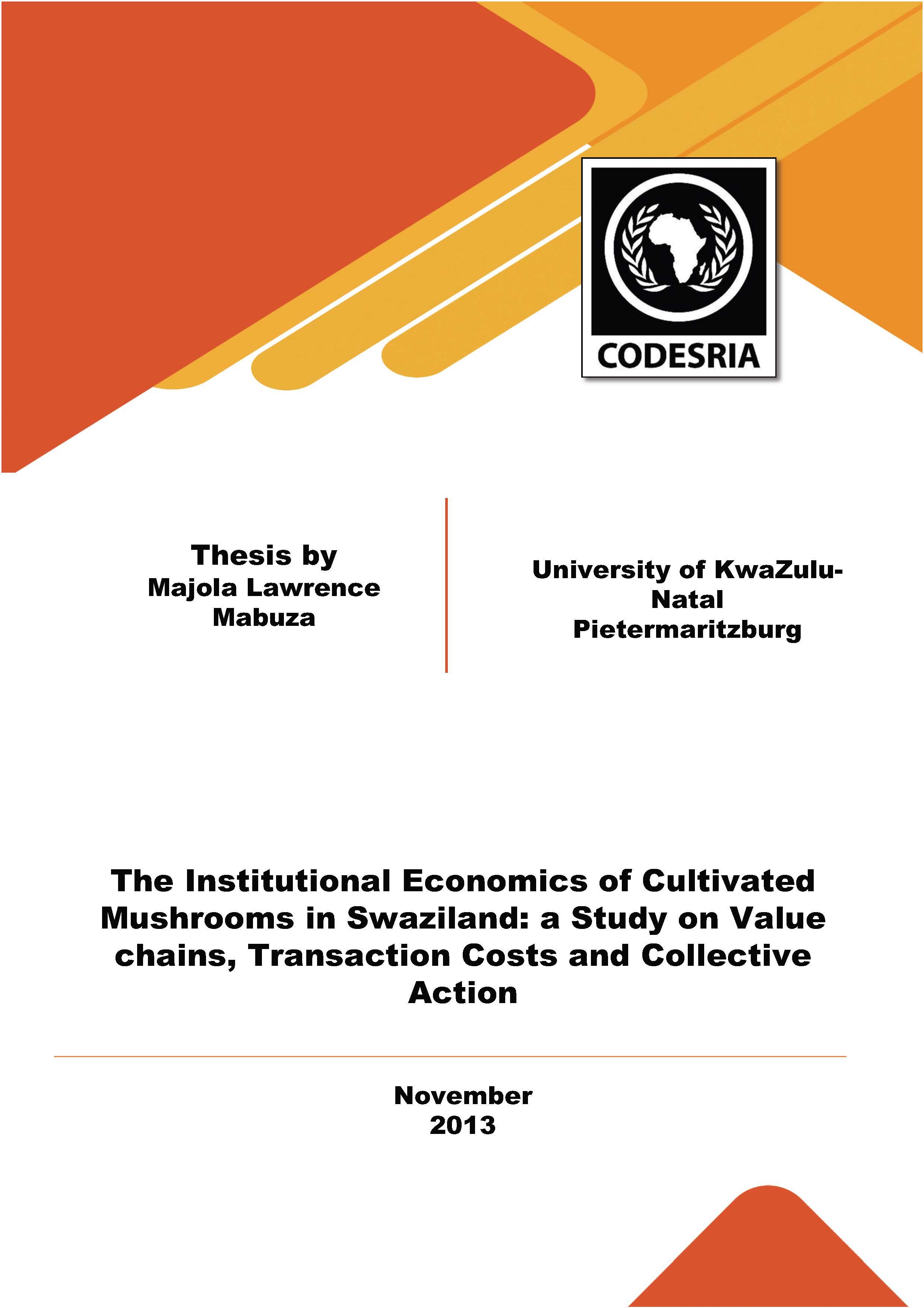The Institutional Economics of Cultivated Mushrooms in Swaziland: a Study on Value chains, Transaction Costs and Collective Action
Keywords:
Agricultural markets, agricultural products, value systems, smallholders, farmers' associations, mushrooms, value chain, transaction costs, SwazilandSynopsis
This study focuses on commercial mushroom production, a relatively new economic activity
in Swaziland that seeks to assist rural-based small-scale farmers to diversify and improve their
economic independence and livelihoods. The mushroom programme is in line with the
National Development Strategy, which, among its major objectives, aims to address povertyrelated
challenges through the promotion of non-conventional high-value agricultural
commodities that have not been explored by local farmers despite having a relatively high
consumer demand in local and international markets. In attempting to provide an impetus to
the mushroom industry, the Swaziland government currently offers free training in mushroom
production, extension services, high quality spawn at a very nominal fee, and free substrate
bags. Considering the geographical suitability and the magnitude of investment made towards
the mushroom development programme, there is a need to understand why many farmers are
not participating in the industry, and why Swaziland still imports more than 95 percent of
locally consumed cultivated mushrooms. There has also been no research so far on the
challenges and opportunities in producing, value adding, and marketing of mushrooms in
Swaziland. This study was, therefore, an attempt to address these knowledge gaps. It also
provided an opportunity to draw relevant policy and management implications to inform
future strategies in the industry. The specific objectives of the study were to: (i) identify and
examine the factors that influence households' decisions to participate in mushroom
production; (ii) study the underlying mushroom production and market access constraints; (iii)
examine the effects of transaction cost factors that influence mushroom producers' market
channel choice decisions and the quantity of mushrooms sold in selected channels; and (iv)
study the effects of organisational form on producers' participation in collective
responsibilities.
Using cross-sectional data gathered from mushroom producers and non-producers, the results
of the Two-Stage Conditional Maximum Likelihood and Two-Stage Probit Least Squares
estimation methods revealed that farmers' decisions to participate in the mushroom enterprise
are mainly influenced by institutional factors. Farmers who have undergone training in basic
oyster mushroom production, are located in close proximity to input and output markets, and
have positive perceptions towards mushrooms, are likely to participate in the mushroom
industry. The development of positive perceptions towards mushrooms is predominantly
influenced by the knowledge gained on their nutritional and therapeutical properties.
Downloads
References
Abadi Ghadim, A.K. and Pannell, DJ. 1999. A conceptual framework of adoption of an
agricultural innovation. Agricultural Economics 21 (2): 145-154.
Adegbola, P. and Gardeboek, C. 2007. The effect of information sources on technology
adoption and modification decisions. Agricultural Economics 37(1):55-65.
Agrawal, A. 2000. Small is beautiful, but is larger better? Forest management institutions
in the Kumaon Himalaya, India. In: Gibson, C., McKean, M. and Ostrom, E.
(eds.), People and Forests: Communities, Institutions, and Governance, 57-86.
Cambridge: MIT Press.
Akavia, E., Beharav, A., Wasser, S.P. and Nevo, E. 2009. Disposal of agro-industrial byproducts
by organic cultivation of the culinary and medicinal mushroom
Hypsizygus marmoreus. Waste Management 29(5):1622-1627.
Albanes, R. and van Fleet, D.D. 1985. Rational behaviour in groups: The free-riding
tendency. The Academy of Management Review 10(2):244-255.
Alene, A.D., Manyong, V.M., Omanya, G., Mignouna, A.D., Bokanga, M. and Odhiambo,
G. 2008. Smallholder market participation under transaction costs: Maize supply
and fertilizer demand in Kenya. Food Policy 33(4):318-328.
Allen, D.W. 1999. Transaction costs. In: Bouckaert, B. and De Geest, G. (eds.),
Encyclopaedia of Law and Economics, Vol. 1, 893-926. Cheltenham: Edward
Elgar.
Allen, D.W. 2006. Theoretical difficulties with transaction cost measurement. Division of
Labour and Transaction Costs 2(1):1-14.
Alvarez, R. and Glasgow, G. 1999. Two-stage estimation of non-recursive choice models.
Political Analysis 8(2):147-165.
Anosike, N. and Coughenour, C.M. 1990. The socioeconomic basis of farm enterprise
diversification decisions. Rural Sociology 55(1):1-24.
Appelbaum, R.P. and Gereffi, G. 1994. Power and profits in the apparel commodity chain.
In: Bonacich, E., Cheng, L., Chinchilla, N., Hamilton, N. and Ong, P. (eds.),
Global Production: The Apparel Jndushy in the Pacific Rim, 42-64. Philadelphia:
Temple University Press.
Araral, E. 2009. What explains collective action in the commons? Theory and evidence
from the Phillipines. World Development 37(3):687-697.






